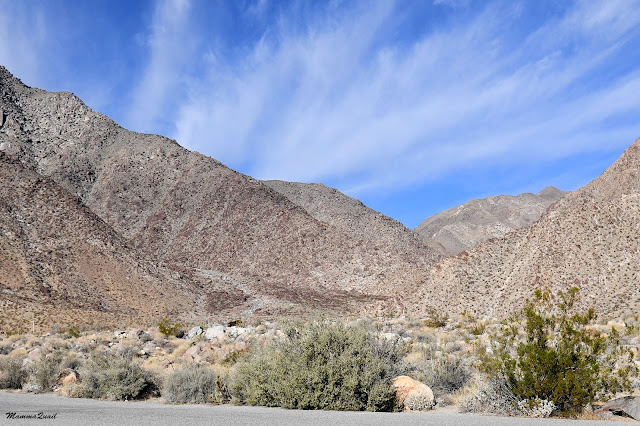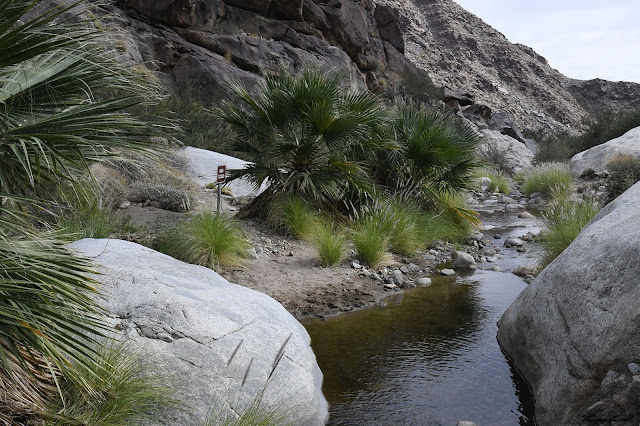 |
| Desert View from the cliff edge at the end of trail |
Date: November 23, 2023
Place: Anza Borrego State Park, Borrego Springs, California
Coordinates: 33.020200, -116.360039
Length: 2.8 miles
Level: easy
The pictograph trail was recommended to us at the Anza Borrego State Park visitor center in the morning before we went hiking at Palm Canyon. After our lunch we drove south to the trailhead of the Pictograph Trail. The way there included driving a good distance on a dirt road which was mostly ok but very sandy. It went through a primitive campground that was partially occupied. The parking area was fairly small, with parking 'stalls' roughly formed by previously parked cars in between the creosote bushes and the boulders that were strewn around.
 |
| At the trailhead |
There were two other cars in the area near one of them were people who looked like they were
about to go on the trail. They must have changed their minds while we
were getting ready however, because by the time we were ready to set out
they went back into their car and drove off.
The trail led us directly into the boulders, meandering between and around them. I enjoyed seeing the lovely rock garden that included desert bushes and cacti, all looking plump and healthy.
The afternoon sun was already pretty low and the north-facing slopes were dark. The lighting was fine for close up shots and all of my broad view shots have an end of day feel to them.
 |
| Rock Horn Cholla, Cylindropuntia acanthocarpa |
 |
| California Juniper, Juniperus californica |
The junipers were laden with pale berries - it was a good year for them. These berries are the staple food of many desert animals, from birds to coyotes. By eating them, and defecating the seeds somewhere else, these animals take an active part in dispersing the junipers far and wide.
 |
| California Juniper, Juniperus californica |
A sole agave inflorescence pole stood sentinel on top of the ridge to our right (south). The agave inflorescence was a silhouette and I was unable to tell if this was an active bloom or an old stalk.
 |
| Desert Agave, Agave deserti |
Every step we took around the curve of the hill revealed more sights. The rock garden scenery continued - featuring yucca plants as well. None of the yucca were blooming.
 |
| Mojave Yucca, Yucca schidigera |
To my utter surprise however, I did see one ocotillo blooming. Nit the entire plant, no. Only the tip of a single branch. A symbolic bloom of sort.
 |
| Ocotillo, Fouqueieria splendens |
The rocky slopes from north and south closed in on the trail once more. There wasn't much of an elevation chance there but the narrowing did give me the sense of walking through a sort of a strait.
 |
| Pictograph Trail |
Here too the intertwined vegetation and the boulders created a beautiful desert rock garden. It probably looks very lovely when the plants are in bloom, but we were there at the end of fall.
The moon was rising. I noticed it and pointed it out to my family. It was nearly full, and, nestled in the slopes depression, it looked like a big, white ball that paused in the middle of a downhill roll.
A couple of ravens were frolicking ahead of us. I tried to catch them on camera. In the southwest direction, illuminated from behind, the raven looked like a silhouette art of a horror book.
 |
| Common Raven |
My chika got a much better image of the ravens after they landed on a boulder further down the trail. They seemed to be very friendly to one another - perhaps a couple or a parent - youth.
 |
| Common Raven |
Just around the big hill we were circumventing on the north was the pictograph Rock. It was a large, smooth boulder with graphic symbols painted on it in red at eyes level.
 |
| Pictograph Rock |
We drew near and took some photos. Pappa Quail commented that in a way they looked like modern day grafitti - makes left behind by random passers by who wanted to make a lasting statement. These pictographs however, are centuries old, and the paints that were used to make them were not as easily accessible as modern day art supplies. There was clearly planning and preparation involved in creating these symbols, and very likely that they did have a significant meaning to the area people of that time.
 |
| Pictgraphs |
These days no one knows what is the meaning if these symbols, not even the contemporary Kumeyaay, to whom these pictographs are sacred to this day.
 |
| Pictgraphs |
Near the pictograph rock I noticed another, lest conspicuous relic of the indigenous people's life in the area - a grinding rock. It was in grinding rocks such as this that the indigenous people used to process food.
 |
| Grinding Stone |
There were a number of large juniper bushes behind the pictograph rock and the elder chika identified a bird in one of them and took its photo.
 |
| Brewer's Sparrow |
We decided to continue past the pictograph rock. The information pamphlet we got at the visitor center had another relics site with more grinding stones marked near the end of the trail and we wanted to see it. The trail wasn't long so we continued walking southeast.
 |
| Trail |
A couple of people came from that direction. We nodded to one another, and they walked back to the trailhead while we continued to the trail end.
Pat the pictograph rock the hills on the sides of the trail were farther apart and once again we were walking through a flat little valley with sandy soil and lots of creosote shrubs. There wasn't much going on in terms of wildlife, not even insects. The pamphlet showed the relics site to be near where the trail entered the hills again, but when we approached we saw nothing of human origin but the trail itself.
We looked around a a bit but, seeing nothing special, we resumed walking and entered the gap between the hills where the creek and the trail squeezed through. This part turned to be a short high-walled canyon that ended with a dry waterfall drop.
The canyon but was already dark, but when we reached its edge we were washed by the late afternoon sunlight again.
 |
| Desert Agave, Agave deserti |
Carefully, I approached the edge of the cliff and looked at the vast desert view that extended below me. The wash itself continued far below, bone dry, all the way to a distant open flat. Behind the large flat loomed the next mountain range, looking hazy at the end of the day.
Pappa Quail and the chikas sat down on the rock. I was a bit uneasy, seeing how close my elder chika was to the big drop (I cropped most of her from this photo but left her knee in the lower right corner). When I told her that she replied drily that I was standing much closer to the edge than where she was sitting ... and she was right. It is more difficult to assess someone else's risk than one's own, especially when that someone else is your child. I took a step back and sat down as well.
After our little break we got back on our feet and turned about, starting our return to the parking area. Back on the northwest side of the canyon bit I searched again for the grinding stones that were supposed to be there according to the pamphlet, but didn't find them on the second search either.
Our way back through the flat valley was much quicker. I didn't tame many photos, only here and there of some plants that looked nice, such as this double yucca in the photo below.
 |
| Mojave Yucca, Yucca schidigera |
The sun was lower now, and when it reached the top of the ridge on the west I stopped and took some photographs of this pre-sunset sunset.
A large sand bar was in the middle of the valley. Pappa Quail and the chikas went ahead on the trail while I moved north to the other side of the sand bar. There I was able to catch yet another pre-sunset, and before that, see the cholla cacti glistening in the last of the day's direct sun rays.
 |
| Rock Horn Cholla, Cylindropuntia acanthocarpa and Mojave Yucca, Yucca schidigera |
The young chika was waiting for me when I returned to the main trail. She pointed out a large, black beetle, similar to the other beetles we've seen in Anza Borrego so far.
 |
| Beetle |
We were walking in the dusky zone now. The pictograph rock looked like a black silhouette now, and the raven sat atop it, a guardian spirit of the native past.
This time we didn't get close to the pictograph rock. Apparently there were other pictographs in the area but, concerned about driving ut in the dark, we simply continued on with our hike.
 |
| Pictograph Rock |
As we got through the first narrow area of the path I got to see one more animal - a colorful insect climbing a ranch of a shrub. I didn't stop long enough for a proper identification but it looked like a nymph of a grasshopper.
It was more illuminated at the top of the first narrow area, and I even caught one sunny spot before it too faded into the dusk. There was a buckwheat plant in bloom, a nice species that I don't recall seeing before.
 |
| Davidson's Buckwheat, Eriogonum davidsonii |
The tiny flat between the narrow and the pass was already under dusk too. The top of the pass was illuminated with direct sunlight still, and I rushed ahead to try and get there before that too, would fade.
I reached the top of the pass in time and looked down to to the trailhead area, and to Blair Valley beyond. The entire valley was till in full daylight. We needn't have rushed outside to avoid driving in the dark. That got me thinking about something, but I kept my mouth shut until the very end of the hike. 

Behind us - the moon was already high in the sky, and looked much smaller. The line of direct light was creeping up steadily. I took a deep breath and followed my family down the trail to the parking area.
The creosote bushes were all in fruit - none of them was blooming. I liked the fairy lantern look of the fruiting creosote, especially when the end of day light shone through the small fuzzballs.
 |
| Creosote, Larrea tridentata |
When we got to the car I finally let my idea out. I suggested that the elder chika would drive us out to the main road. She's been a fine driver on paved road but had very little experience on dirt roads. Hearing my suggestion, the elder chika immediately jumped into the drivers seat. Pappa Quail turned pale, and moved to the back so he won't have to sit next to her. (I did). The younger chika, who had got her license less than half a year ago protested loudly that she wasn't offered to drive ... I pacified her by promising her an off pavement experience in Moab, where we had planned to go for the winter break. We got in the car and enjoyed a very bumpy but joyful ride back to our lodge. On the morrow we would begin our long drive back home.




































































